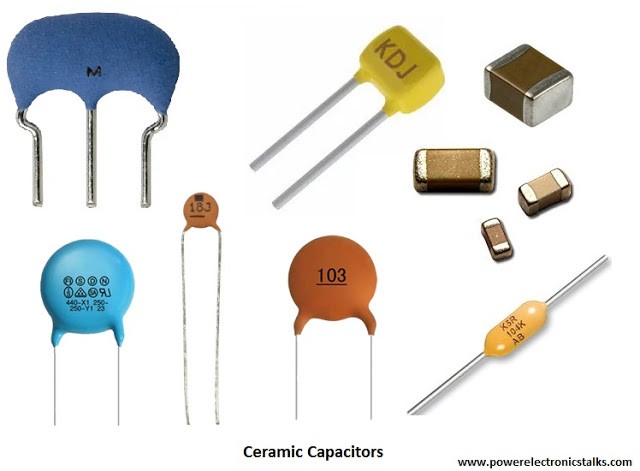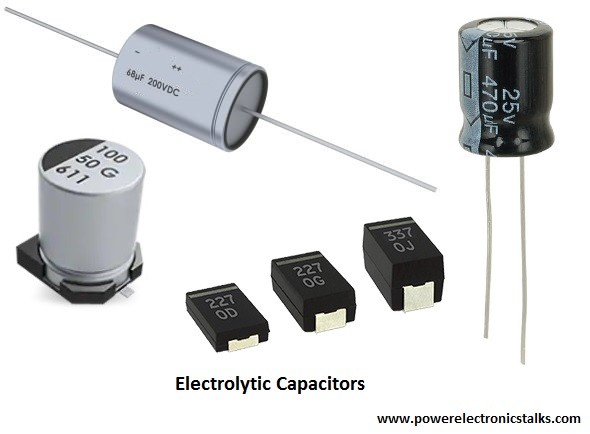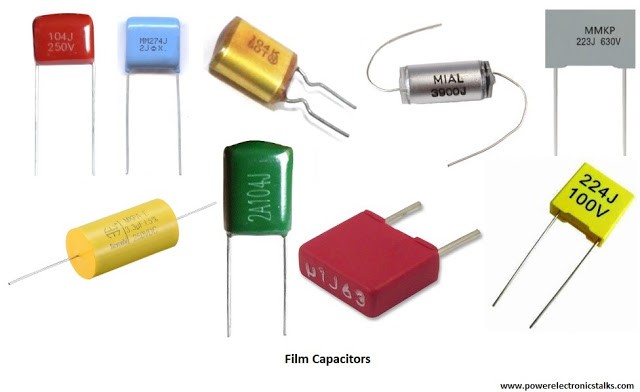Different Types of Capacitors and Their Applications
There are many Types of Capacitor and according to the advantages, disadvantages and applications we can select capacitor type and capacitance value. In this article, we will discuss about different Types of Capacitor.
Ceramic capacitors
Ceramic capacitors are non-polarized fixed capacitors. They are made by two layers or some times more than two layers of ceramic and metal. Here finely powdered granules of ceramic material are used as dielectric and both the side two metal electrodes are attached.
 |
| Ceramic Capacitors |
Type of Capacitor – Class 1 Ceramic
Used Dielectric Material – Para-electric ceramic combination of Titanium dioxide aended by additives.
Advantages – These types of capacitors gives predictable linear and low capacitance value change with working temperature. These capacitor types have superb high frequency characteristics with low losses.
Drawbacks – Used ceramic have low permittivity, low volumetric efficiency these types of capacitors have, compare to Class2 capacitors these have larger dimensions.
Applications – These capacitors can be use for temperature compensation in resonant circuit. These capacitors can support voltages up to 15,000V.
Type of Capacitor – Class 2 Ceramic
Used Dielectric Material – Ferroelectric ceramic mixture of Barium Titanate and appropriate additives
Advantages – These types of capacitors have high permittivity and high volumetric efficiency. These capacitors are smaller in dimensions as compare to Class 1 ceramic capacitors. These are available in voltages up to 50,000V.
Drawbacks – As compare to Class 1 ceramic these capacitors have lower stability and higher losses. Capacitance of these capacitor changes with change in the applied voltage, frequency and aging effects. These are slightly microphonic. Microphonics or microphony defines the process or phenomenon where some components in electronic devices change mechanical vibrations into an undesired electrical signal i.e. noise.
Applications – Applications of these capacitors are mostly for buffer, for by-pass and also used as coupling capacitor.
Film capacitors
Film capacitors or plastic film capacitors have no polarity. This capacitor type uses thin layer of an insulating plastic film as the dielectric. This thin dielectric film wound in cylindrical shape and at both the side metallic electrodes is attached.
 |
| Film Capacitors |
Type of Capacitor – Film/foil based film capacitors
Used Dielectric Material – Polypropylene (PP), Polyester (PET), Polytetrafluoroethylene (PTFE)
Advantages – These capacitors can sustain highest surge ratings/pulse voltages. As compare to metallized types here peak currents are higher.
Drawbacks – These capacitors don’t have self-healing properties. These capacitors have larger dimensions than metallized film capacitors.
Applications – These capacitors are widely used in power electronics applications like DC Link, DC output filtering and as IGBT snubbers.
Type of Capacitor – Metallized film capacitors
Used Dielectric Material – Polypropylene (PP), Polyester (PET), Polyethylene naphthalate (PEN), Polyphenylene Sulfide (PPS), Polytetrafluoroethylene (PTFE)
Advantages – These capacitors are considerably smaller in size as compare to film/foil types and these capacitors have self-healing characteristics.
Drawbacks – Thin metallized electrodes limits the full current carrying ability of these capacitors.
Applications – These capacitors are widely used in power electronics applications like DC Link, DC output filtering and as IGBT snubbers.
Type of Capacitor – Polypropylene (PP) film capacitors
Used Dielectric Material – Polypropylene
Advantages – This dielectric is most common film for capacitor. Here in these capacitors low capacitance change with operating temperature. Class – 1 application like frequency-determining circuits and precision analog applications these capacitors are suitable. Capacitance range in these capacitors is in narrow range and have low dissipation factor. Advantage of low moisture absorption makes it suitable for the designs where coating is not needed. Also these capacitors have high insulation resistance.
Drawbacks – These capacitors have maximum operating temperature of 105 °C and also have relatively low permittivity of 2.2. As compare to other capacitors these capacitors are larger than other film capacitors. For pulsed power applications these capacitors mostly damaged from transient over-voltages or voltage reversals as compare to MKV-capacitors.
Applications – Mostly these capacitors are used in high power applications such as snubber or IGBT and in AC power applications for power factor correction in motors. We can see these capacitors in high frequency and high power applications like induction heating. Also they are used for safety/EMI suppression.
Type of Capacitor – Polyethylene naphthalate (PEN) film capacitors
Used Dielectric Material – Polyethylene naphthalate (Kaladex®)
Advantages – As compare to PET capacitors these capacitors are more stable at high temperatures. More appropriate for high temperature applications.
Drawbacks – As compare to PET capacitors they have lower relative permittivity and lower dielectric strength, which results in larger dimensions for a capacitance value and rated voltage.
Applications – As temperature requirements are not important they are mainly used for non-critical filtering, coupling and decoupling.
Type of Capacitor – Polyester (PET) film (Mylar) capacitors
Used Dielectric Material – Polyester (Hostaphan®, Mylar®), Polyethylene terephthalate
Advantages – These capacitors are in smaller in size as compare to polypropylene film capacitors. Advantage of low moisture absorption makes them to appear in most DC applications. They can work up to 60,000Vdc.
Drawbacks – We can use them only for frequency application. Restricted use in power electronics because of higher losses, which appears because of increase in temperature and frequency.
Applications – They are mainly used for general purpose applications or semi-critical circuits with operating temperatures up to 125°C.
Type of Capacitor – Polyphenylene Sulfide (PPS) film capacitors
Used Dielectric Material – Polyphenylene (Torelina®)
Advantages – These capacitors have quality of small temperature dependency over the whole temperature range and also they have narrow frequency dependency in a wide frequency range. The dissipation factor of these capacitors is relatively small and steady. Working temperature of this capacitor is up to 270 °C.
Drawbacks – The dissipation factor increases when the temperature crosses 100°C, which further increases capacitor temperature, but it will not cause any critical problem and can work without degradation. Cost is usually higher than Polypropylene (PP) film capacitors.
Applications – Mostly suitable for SMD package application.
Type of Capacitor – Polytetrafluoroethylene (PTFE) capacitors (Teflon film capacitors)
Used Dielectric Material – Polytetrafluoroethylene (Teflon®)
Advantages – These capacitors have less loss and have working temperature up to 250°C. These capacitors have very high insulation resistance and good constancy.
Drawbacks – Because of low dielectric constant they have large size. As compare to other film capacitors these capacitors have high cost.
Applications – Used in critical applications.
Type of Capacitor – Polystyrene (PS) film capacitors
Used Dielectric Material – Polystyrene (Styroflex)
Advantages – This capacitor have good thermal stability and high insulation along with low distortion.
Drawbacks – As these capacitors are replaced by Polyester (PET) film (Mylar) capacitors so, limited manufacturers produce this capacitor.
Applications – Same like Polyester (PET) film (Mylar) capacitors
Type of Capacitor – Polycarbonate (PC) film capacitors
Used Dielectric Material – Polycarbonate
Advantages – Advantages are same like Polypropylene (PP) film capacitors.
Drawbacks – As these capacitors are replaced by Polypropylene (PP) film capacitors so, limited manufacturers produce this capacitor.
Applications – Same like Polypropylene (PP) film capacitors
Type of Capacitor – Polysulfone film capacitors
Used Dielectric Material – Polysulfone
Advantages – Endure full voltage at relatively high temperatures.
Drawbacks – Only development and hard to find.
Applications – Same like Polycarbonate (PC) film capacitors and Polypropylene (PP) film capacitors
Type of Capacitor – Polyamide film capacitors
Used Dielectric Material – Polyamide
Advantages – Operating temperatures of up to 200°C. High insulation resistance. Good stability. Low dissipation factor.
Drawbacks – Only development and hard to find.
Applications – These capacitors are used in critical applications.
Type of Capacitor – Polyimide film (Kapton) capacitors
Used Dielectric Material – Polyimide (Kapton)
Advantages – Highest dielectric strength of any known plastic film dielectric.
Drawbacks – Only development and hard to find.
Applications – These capacitors are used in critical applications.
Power film capacitors
The construction of this capacitor is same like normal film capacitors, but this type of capacitor supports high voltage application in electrical installations. As, it deals with high voltage and may cause safety risk to people and applications, a certification or product approval from local regulating authority is must needed.
 |
| Power Film Capacitors |
Type of Capacitor – Metallized paper power capacitors
Used Dielectric Material – Paper impregnated with insulating oil or epoxy resin
Advantages – These capacitors supports self-healing. Mostly wax or oil is used but for high voltage applications oil-Kraft paper is used.
Drawbacks – Size of this capacitor is large and heavy as compare to PP dielectric. These capacitors are very hygroscopic i.e. it absorbs moisture from the air which causes dielectric losses and decreases insulation resistance.
Applications – High voltage applications and supports all Polypropylene (PP) film capacitor applications.
Type of Capacitor – Paper film/foil power capacitors
Used Dielectric Material – Kraft paper impregnated with oil
Advantages – Low cost because of paper covered with metal foils as electrodes.
Drawbacks – Size of this capacitor is large and heavy as compare to PP dielectric. Not support self-healing. High stored energy may cause catastrophic failure.
Applications – These capacitors are used in the applications related to high discharge voltage.
Type of Capacitor – Single- or double-sided metallized PP power capacitors
Used Dielectric Material – PP as dielectric, impregnated with insulating oil, epoxy resin or insulating gas.
Advantages – This capacitor supports high capacitance value and also heals it-self.
Drawbacks – This type of capacitor are not reliable for high voltage operation and very high inrush current loads. Supported heat resistance is 105°C.
Applications – This type of capacitors are used in general purpose applications, AC applications, motors, filtering, snubbing, series resonant DC circuits, DC discharge, AC commutation, power factor correction, AC damping and DC links.
Type of Capacitor – PP dielectric, field-free paper power capacitors (MKV power capacitors)
Used Dielectric Material – Double-sided (field-free) metallized paper as electrode carrier. PP as dielectic, impregnated with insulating oil, epoxy resin or insulating gas.
Advantages – These capacitors supports self-healing and low losses. These have high insulation resistance and can sustain inrush current.
Drawbacks – Size of this capacitor is larger than PP power capacitors.
Applications – These types of capacitors are used in heavy duty applications like; commutating with high reactive power, high frequencies and high peak current load.
Type of Capacitor – PP film/foil power capacitors
Used Dielectric Material – Impregnated PP or insulating gas, epoxy resin or insulating gas, insulating oil
Advantages – It can sustain highest inrush current.
Drawbacks – Size of this capacitor is more as compare to the PP metallized versions and also didn’t heal it-self.
Applications – This type of capacitors are used in general purpose applications, AC applications, motors, filtering, snubbing, series resonant DC circuits, DC discharge, AC commutation, power factor correction, AC damping and DC links.
Electrolytic capacitors
Electrolytic capacitors are polarised capacitors and for proper identification negative (-) sign is marked on the capacitor body. These types of capacitor are generally used when very high capacitance values are needed.
 |
| Electrolytic Capacitors |
This capacitor type has a metal anode concealed with an oxidized layer which is used as dielectric material. The second electrode is in the form of non-solid or semi-liquid or solid electrolyte. This is usually the cathode.
The dielectric is a very thin layer of oxide sometimes less than ten microns. Because of this there is very small distance between plates and hence we can get large capacitance value with small size of capacitor.
